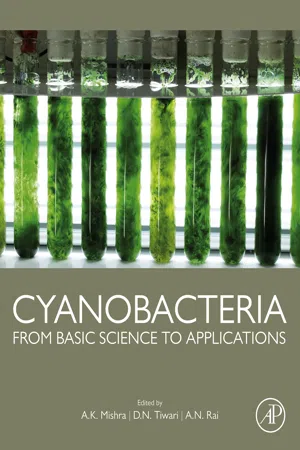1 Introduction
Cyanobacteria are oxygen evolving, gram-negative, photoautotrophic bacteria that can be found in virtually all imaginable habitats across the world. They can be found in habitats extending from the extremely cold deserts of the Arctic and Antarctic Zones (Mataloni and Komárek, 2004) to the very extreme hot springs of the Yellowstone National Park, thus representing an interesting form of life in a wide range of aquatic and terrestrial environments (Whitton and Potts, 2000a,b). This extraordinary expanse of cyanobacteria is actually a result of an important character that the cyanobacteria can boast of which we refer to as “adaptability.” Their amazing success in adapting to such diverse and varying habitats can be attributed to a very long-standing evolutionary history that cyanobacteria enjoy. Some of the modern physiological and anatomical features of cyanobacteria that have helped in supporting their long history on Earth include an extremely high tolerance level of low oxygen and free sulfide, the ability to utilize H2S as a photoreductant in place of H2O, and the strong tolerance capacity for ultraviolet B and C radiations (Whitton and Potts, 2000a,b). Thus, these are some of the major adaptive features that have allowed the cyanobacteria to grow, flourish, and dominate in habitats where many other forms of life are absolutely unknown or may struggle to even survive.
Interestingly, the origin of cyanobacteria and their basic anatomical features are typical bacterial type but their ecological, biological, and morphological features are quiet specific and diverse too (Flores et al., 2006; Kalaitzis et al., 2009; Flores and Herrero, 2010). The almost essential possession of some interesting features like the ability of buoyancy, performing oxygenic photosynthesis, and fixation of atmospheric nitrogen (Walsby, 1994; Castenholz, 2001; Burja et al., 2001; Berman-Frank et al., 2003) make the cyanobacteria more special and capable to adapt to varied conditions in both normal and stressed habitats. As a consequence of such strong survival capabilities, they also act as prominent phototrophic primary producers in natural ecosystems (Field et al., 1998; Bryant, 2003).
Cyanobacteria have played a major role in the evolution of different forms of life on Earth. The anaerobic earth was converted to the aerobic one by the cyanobacteria about 2 billion years ago, thus finally supplying oxygen to the atmosphere through oxygenic photosynthesis for approximately 1.5 billion years (Berman-Frank et al., 2003; Schopf et al., 1983). This event of oxygenation of the Earth’s atmosphere allowed for an enormous degree of greater diversification of many forms of life on the Earth. Apart from the oxygenation, cyanobacteria also influenced the advancement of life on Earth by shaping up themselves as the progenitors of chloroplasts (Giovannoni et al., 1988; Sergeev et al., 2002), ultimately leading to a broader diversification of algae and land plants.
In the current times, the cyanobacteria still continue to affect the life on Earth, as the major oxygen producers on this planet. Apart from being the major oxygen producers, many of them are also efficient fixers of atmospheric nitrogen thus making them extremely important components of nutrient-deprived ecosystems and extreme environments all throughout the Earth. As a result of their high adaptive capacity, cyanobacteria are also well known to form a wide range of nitrogen-fixing symbiotic relationships with representatives from almost all plant groups such as algae (Hemiaulus hauckii-Richelia intracellularis) fungi (Geosiphon pyriforme-Nostoc), bryophytes (Anthoceros-Nostoc), pteridophytes (Azolla-Anabaena), gymnosperms (Cycas-Nostoc), and angiosperms (Gunnera-Nostoc), thus supplying the host organisms with a lot of fixed nitrogen and in return, acquiring carbohydrates from the host (Morot-Gaudry and Touraine, 2001), thus allowing the host organisms to grow in regions where they may otherwise not survive at all.
Cyanobacterial diversity owing to their adaptive capacities occupies incredibly large canvas of the planet Earth. The expanse of their diversi...
